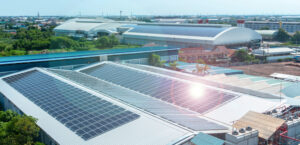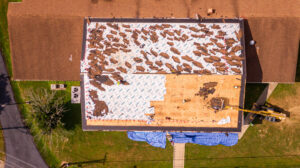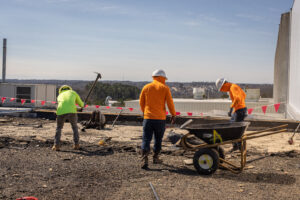As a commercial roofing contractor, I know firsthand the importance of proper insulation in commercial roofing. Insulation plays a vital role in regulating temperature, preventing energy loss, and enhancing the overall performance of your commercial roofing system. In this blog post, we will explore the benefits of proper insulation, the types of insulation available for commercial roofing, factors to consider when choosing insulation, installation techniques and best practices, as well as insulation maintenance and repair.
The Benefits of Proper Insulation
Proper insulation can help you save money, improve building comfort, enhance roof durability, and comply with building codes and regulations. Here are some of the benefits of having good insulation in your commercial roofing system:
Energy Savings and Cost Efficiency
One of the most significant benefits of proper insulation is energy savings. A well-insulated commercial roof can help regulate temperature and reduce energy loss, resulting in lower energy bills and cost efficiency. By keeping the heat in during the winter and out during the summer, insulation can help you maintain a consistent indoor temperature without overworking your HVAC system.
Increased Building Comfort
Proper insulation can also enhance the comfort of your commercial building by reducing temperature fluctuations, minimizing drafts, and preventing moisture build-up. This can lead to a more comfortable and productive work environment for building occupants.
Improved Roof Durability and Longevity
Insulation can also help protect your commercial roofing system from weather-related damage, such as thermal expansion and contraction, ice dams, and moisture intrusion. By minimizing the impact of external weather conditions on your roof, insulation can help increase its lifespan and reduce the need for repairs.
Compliance With Building Codes and Regulations
Proper insulation is also essential for compliance with building codes and regulations. Depending on your location, building codes may require a certain level of thermal resistance, or R-value, for commercial roofing insulation. Failing to comply with these requirements can lead to fines, legal issues, and safety hazards.
Types of Insulation for Commercial Roofing
Several types of insulation are available for commercial roofing, each with its own set of advantages and disadvantages. Here are some of the most common types of insulation:
Spray Foam Insulation
Spray foam insulation is a popular option for commercial roofing because it provides excellent thermal insulation and air-sealing properties. It can be applied directly to the underside of the roof deck, filling in gaps and creating a seamless barrier against energy loss and moisture intrusion. Spray foam insulation is also durable and long lasting, with an average lifespan of up to 30 years.
Rigid Board Insulation
Rigid board insulation is a versatile option that comes in several different materials, including polystyrene, polyisocyanurate, and extruded polystyrene. It is often used for flat or low-slope roofs and can be installed above or below the roof deck. Rigid board insulation is lightweight, easy to handle, and provides excellent thermal resistance.
Fiberglass Insulation
Fiberglass insulation is a traditional and cost-effective option for commercial roofing. It is made of spun glass fibers and is installed between the roof deck and the interior ceiling. Fiberglass insulation is easy to install and can provide adequate thermal resistance if installed correctly.
Mineral Wool Insulation
Mineral wool insulation, also known as rock wool, is a fire-resistant option that is made of natural or recycled materials. It is often used in commercial buildings that require additional fire protection, such as hospitals and schools. Mineral wool insulation is also resistant to moisture, pests, and mold.
When choosing insulation for your commercial roofing system, it is essential to consider factors such as climate, building structure, use, budget, and environmental impact. Your roofing contractor can help you determine which insulation type is best suited for your specific needs.
Insulation Installation Techniques and Best Practices
Proper insulation installation is critical for achieving maximum energy efficiency, roof durability, and compliance with building codes. Here are some best practices and techniques for installing insulation in commercial roofing:
Install Vapor Retarders
A vapor retarder is a layer of material that is installed between the insulation and the roof deck to prevent moisture from penetrating the roofing system. Vapor retarders can help prevent the buildup of moisture in the insulation and the roof deck, which can lead to mold growth and decreased insulation effectiveness. It is essential to choose a vapor retarder with a perm rating that is appropriate for your climate and roofing system.
Maintain Proper R-Value
The R-value is a measure of thermal resistance, or the ability of insulation to resist heat flow. Building codes typically require a specific R-value for commercial roofing insulation, depending on your location and climate. It is essential to ensure that your insulation meets or exceeds these requirements to achieve maximum energy efficiency.
Minimize Thermal Bridging
Thermal bridging occurs when heat moves through areas of low insulation, such as gaps and joints in the roofing system. This can lead to energy loss, condensation, and reduced insulation effectiveness. It is crucial to minimize thermal bridging by using continuous insulation and sealing gaps and joints with spray foam or other sealants.
Consider Sustainability
Sustainability is an increasingly important factor to consider when choosing insulation for your commercial roofing system. Sustainable insulation options, such as recycled materials or bio-based materials, can help reduce the environmental impact of your roofing system while providing excellent thermal insulation.
Insulation Maintenance and Repair
Proper insulation maintenance and repair can help extend the life of your commercial roofing system and prevent energy loss and other issues. Here are some tips for maintaining and repairing your insulation:
Inspect Insulation Regularly
Regular inspections can help identify any insulation issues, such as moisture buildup or insulation compression. Inspections should be conducted at least once per year or after severe weather events.
Repair Insulation Promptly
Any insulation issues should be addressed promptly to prevent further damage or energy loss. Insulation repairs can include adding additional insulation, replacing damaged insulation, or sealing gaps and joints.
Upgrade Insulation as Needed
As your commercial building’s needs change, you may need to upgrade your insulation to achieve maximum energy efficiency and compliance with building codes. Your roofing contractor can help you determine if an insulation upgrade is necessary and which type of insulation is best suited for your needs.
In conclusion, proper insulation is critical for achieving energy efficiency, roof durability, and compliance with building codes in commercial roofing. By understanding the benefits of insulation, the types of insulation available, installation best practices, and maintenance and repair strategies, you can maximize the lifespan and performance of your commercial roofing system. As always, it’s essential to work with a reputable commercial roofing contractor to ensure that your insulation is installed correctly and to the highest quality standards.






